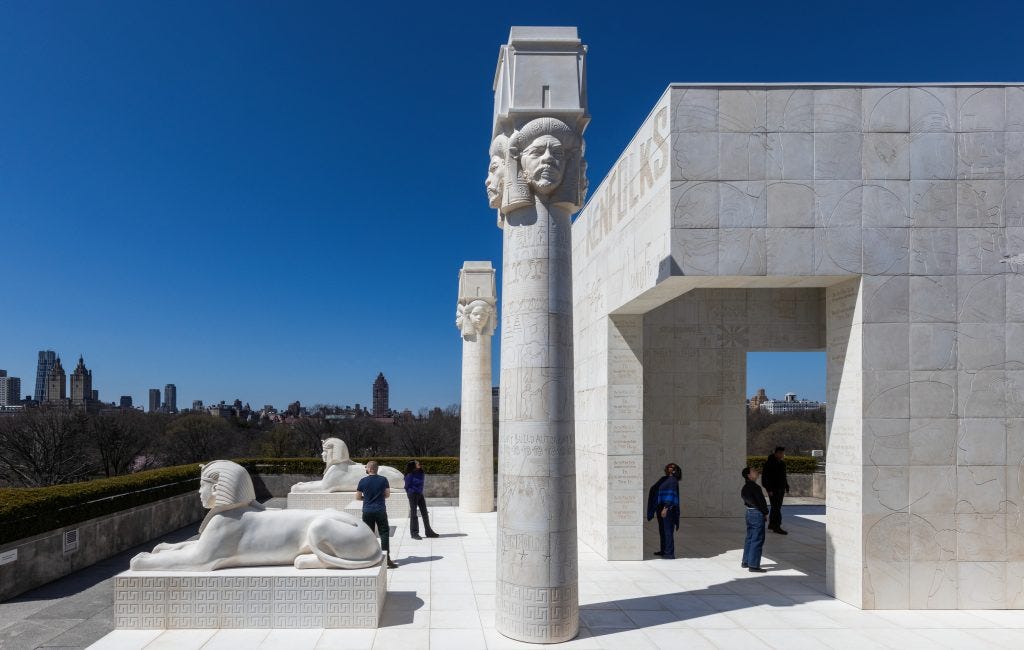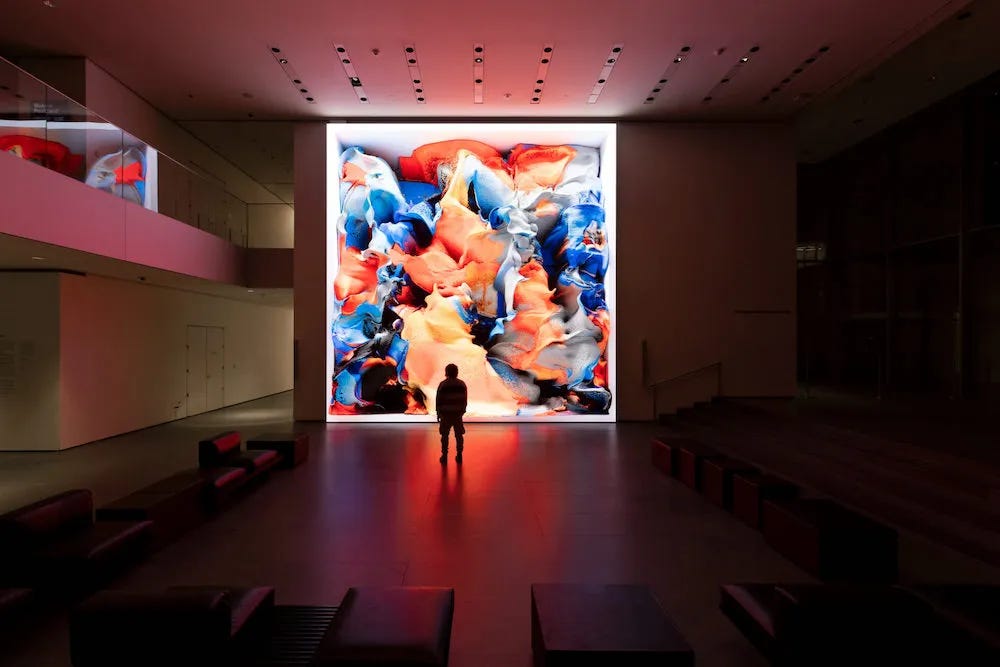How to Get Your Artwork into MoMA
And Showcase Your Art on The Met Rooftop and Auction It for Over $500K
I first sent this post to 100 subscribers in November 2023. Several people scoffed at the title's simplicity, claiming that it downplayed the complexity of gaining admission to prestigious institutions like MoMA or the MET.
While I acknowledge their concern, I believe that striving for this milestone is possible based on the career patterns of artists who have achieved this pinnacle of artistic excellence. There is a potential path that can be loosely followed, and of course, let’s not discount luck.
This post is pretty much the same, except for updates to the grammar (thank you, Grammarly!) and an announcement.
I will host a live video session with Will Noel Clarke, a gallerist and curator from London, next Wednesday, March 12th, at 10 a.m. EST. While this will not be a one-on-one session, he will strive to address the careers of as many artists who submitted their work for his expert guidance as possible within 45 minutes. Please join us if you can. The session will also be recorded.
In the future, I will invite many industry experts; paid subscribers can directly submit questions about their careers to these experts.
Moving on - For this article, I examined the careers of three artists and what it took for them to hit crucial, enviable milestones. This post finds parallels among these artists’ careers. The goal is to look for elements that might be attributed to luck and others that could serve as practical insights for artists seeking to apply similar strategies in their artistic practices.
Here are the defining moments of Lauren Halsey, Refik Anadol, and Robert Nava’s careers, or the one thing that people would remember about them:
Lauren Halsey’s MET rooftop commission
Refik Anadol’s MoMA exhibit and acquisition
Robert Nava’s Philips London auction record of 717,008 USD
The Stair Step Approach
While there could be a lot of luck involved in these accomplishments, there is also a pattern of producing high-impact work for an extended period.
According to a research paper on Success and Luck in Creative Careers, the people with the most consistent skills and abilities are the ones who are likely to come out on top in careers where success fluctuates a lot, like art, music, movies, and even science. Seth Godin explains it best in the Indie Hackers podcast.1 Rewritten for clarity.
..in a podcasting workshop I ran with Alex DePalma, participants often expressed a desire for their podcast to excel if they could get someone like Michelle Obama as a guest. However, it's unrealistic to think she would agree immediately. So, work backward: consider someone more accessible, like your next-door neighbor, as your initial guest. Gradually, as you build credibility, you might find your 12th or 100th guest to be someone of Michelle Obama's stature.
This stair-step approach of slowly climbing to the top by applying to bigger and better schools, residencies, and galleries has been key to Halsey and Anadol's getting into MET and the MoMA. Their ability is the main driver here, not luck. They intentionally or unintentionally worked backward from these defining milestones.
Their slow and steady progression towards bigger and better opportunities is a masterclass in steady growth. Here is Anadol’s path towards MoMA.
Antilop was a small art and technology studio Anadol started with his friends in Turkey. His journey from there to MoMA took around 13 years of consistently producing groundbreaking work and moving up the food chain with bigger and better projects. You can read about his career journey in one of my earlier posts.
Telling your story skillfully
Robert Nava's artistic success is more challenging to quantify compared to Halsey and Anadol. While Halsey and Anadol tackle intricate installations with robust narratives, drawing from experiences like growing up in South Central LA and reshaping art in the age of AI and machine learning, Nava's work appears simpler, resembling a drawing by a six-year-old. Additionally, being a white man from Chicago, his background may not immediately capture attention or seem as inherently interesting at first glance.
In my view, Nava would be considered in the 'high luck' category if it weren't for the compelling narrative he weaves into his pieces. Despite having a prestigious background—having attended Yale and earned an undergraduate degree in art—his art, initially not characterized by its raw, naive style, took inspiration from his gritty Bushwick neighborhood and favorite artists like Huma Bhabha. However, he gained significant attention only when he loosened his hold on his career, embraced enjoyment, and leveraged additional platforms, particularly Instagram, where he was discovered.
Nava actively reduced the element of luck by making himself more discoverable through various mediums. At the same time, he continued to showcase his work as a truck driver to support himself. While Halsey and Anadol's careers resemble the strategic journeys of architects or graphic designers, Nava's path epitomizes the narrative of a struggling artist—a story of redemption and inspiration. The description of his work on a gallery website resonates with me, making me very inclined to invest in his art if I had the means:
Nava’s distinctive visual language is highly personal. It is culled from a myriad of sources that range from ancient Sumerian, Egyptian, and Mayan art, and prehistoric cave paintings, to the powerfully symbolic mandala and such tropes of popular culture as gaming imagery and fantasy genre movies.
Network Effects
The ability to make a living from your art is closely tied to how much collectors or institutions are willing to pay for your work, measuring success through external recognition. Albert-László Barabási, a renowned physicist, explains the challenge of gauging the quality of contemporary art in a Big Think video2. He talks about how difficult it is to measure how good a piece of contemporary art is. There is no chronometer or measuring tape. It all depends on a complex network around the artist - who the artist is, where they have exhibited before, who owns it, and how these multiple links connect to the art history canon. In this case, we can map these dependencies.
As it turns out, the most central nodes are the most powerful art institutions like MoMA, Tate, Gagosian, etc. Barabási says that if you give him the first five exhibitions for an artist, he could predict where the artist would be in 15 to 20 years from now. While this seems an exaggeration, one can see where he is going with this. The art market depends on institutional gatekeepers, and the network of how the gatekeepers are connected determines your access to the art market. Artists like Nava, Halsey, and Anadol strategically showcased their work widely to navigate and establish themselves within these influential networks. Understanding and engaging with the networks surrounding their art is crucial for artists seeking recognition and success.
Finding your people
Art customers have diverse tastes and preferences. Essentially, the more someone knows about a specific artist, the greater their satisfaction from consuming that artist's work. This insight suggests that individuals who are more acquainted with a particular artist are likely to purchase more from that artist than others. This conclusion is drawn from a research paper exploring the impact of gallery and artist reputation on prices in the art market.3
In this context, local networks play a crucial role. Halsey's visibility in the LA art scene, Anadol's connection with niche art and tech communities, and Nava's presence in the ultra-contemporary art scene in NYC are all instrumental.
As Seth Godin highlighted in the previously mentioned podcast, consistently showing up in the same place is essential. This emphasizes the significance of sustained presence and engagement within specific networks for artists seeking recognition and success.
“So when I was in the book business, I had nothing for a year, and then people started returning my call, then they would go to lunch with me, because I kept showing up, and so by the time I did the Stanley Kaplan test prep books, they paid a silly amount of money for them, because they trusted me because I had been showing up for 4 years, whereas when I briefly showed up in the film industry, they were like, we got people fly by here all the time, check back in when you’ve failed 40 times.”
Art collectors don’t want to incur switching costs like any other consumer, so finding your niche and developing trust is key.
Revenue Streams
Apart from earning through commissions and selling art, Halsey engages in brand collaborations, such as the one with Nike, while Anadol uses his art as a backdrop for events like the Grammies. I have mixed feelings about these income-generating activities, but they are common practices among artists. Many artists, for instance, put their art on items like cups and t-shirts, selling them on platforms like Red Bubble.
Barabási emphasizes the distinction between the long game and the short game in the art world. Just like scientists, relevant artists leave a lasting legacy for future generations. The question arises: Do these artists sustain themselves through their art or struggle financially only to be recognized posthumously? In such a scenario, selling t-shirts until achieving widespread recognition doesn't seem like a bad idea.
Ramen profitability
This concept is well-known in the startup world, where founders aim to reach a point of self-sustainability as their primary goal. This principle is applicable in the art world, too. Take Nava, for instance; he lives and works in the same space, eliminating the need for a separate studio and reducing costs. Additionally, he supported himself by driving trucks for 6-7 years. On the other hand, Halsey operated from her Grandma's garage well into her career and still relies on support from family and friends for her creative endeavors. By adopting a frugal lifestyle, they extended their financial runway, enabling them to create more art and increase their chances of success through continued exposure.
Conclusion
In summary, the key findings emphasize the importance of sustained skill development, intentional narrative crafting, strategic network engagement, niche identification, and diversified revenue streams for artists navigating the complex landscape of a creative career. These insights are drawn from the collective experiences of Halsey, Anadol, and Nava, offering a roadmap for aspiring artists.
Consistent High-Impact Work: Success correlates with consistently producing high-impact work over time.
Stair Step Approach: Gradual career progression through education and opportunities is crucial.
Narrative and Discoverability: Crafted narratives and strategic use of platforms reduce reliance on luck.
Strategic Network Engagement: Success depends on external recognition, emphasizing the importance of influential networks.
Hyper-Local Networks and Trust: Building trust within specific networks, like local art scenes, is vital.
Diversified Revenue Streams: Exploring alternative revenue sources beyond traditional avenues is common.
Ramen Profitability and Frugal Living: Living frugally and managing resources strategically increase the likelihood of artistic success.
Another thing - over the past 10 years, I have written a few winning grants. If you refer Science of Art to friends, you will receive a PDF of one of the winning grants over email. If you are the grant-applying type, I hope these examples of grant applications will be helpful to you and will persuade you to refer some friends.








